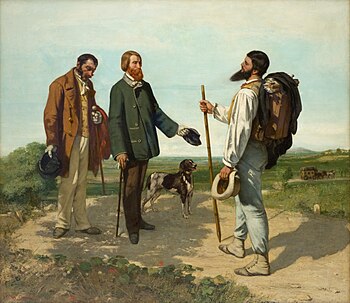
Back Realisme (kunste) Afrikaans Realismus (Kunst) ALS واقعية (فن) Arabic الواقعيه ARZ Realizm (incəsənət) Azerbaijani Реализъм Bulgarian বাস্তবতাবাদ (শিল্পকলা) Bengali/Bangla Realisme Catalan Realismus (umění) Czech Реализм (илемлĕх) CV

Realism in the arts is generally the attempt to represent subject matter truthfully, without artificiality and avoiding speculative and supernatural elements. The term is often used interchangeably with naturalism, although these terms are not synonymous. Naturalism, as an idea relating to visual representation in Western art, seeks to depict objects with the least possible amount of distortion and is tied to the development of linear perspective and illusionism in Renaissance Europe.[1] Realism, while predicated upon naturalistic representation and a departure from the idealization of earlier academic art, often refers to a specific art historical movement that originated in France in the aftermath of the French Revolution of 1848. With artists like Gustave Courbet capitalizing on the mundane, ugly or sordid, realism was motivated by the renewed interest in the common man and the rise of leftist politics.[2] The realist painters rejected Romanticism, which had come to dominate French literature and art, with roots in the late 18th century.
In 19th-century Europe, "Naturalism" or the "Naturalist school" was somewhat artificially erected as a term representing a breakaway sub-movement of realism, that attempted (not wholly successfully) to distinguish itself from its parent by its avoidance of politics and social issues, and liked to proclaim a quasi-scientific basis, playing on the sense of "naturalist" as a student of natural history, as the biological sciences were then generally known.
There have been various movements invoking realism in the other arts, such as the opera style of verismo, literary realism, theatrical realism and Italian neorealist cinema.
- ^ Sarah Dillon and Amy Raffel (October 2014). "Italian Renaissance Art (1400–1600)". Art History Teaching Resources. AHTR. Retrieved November 6, 2021.
- ^ "Metropolitan Museum of Art". Metmuseum.org. June 2, 2014. Retrieved July 15, 2014.